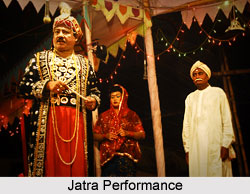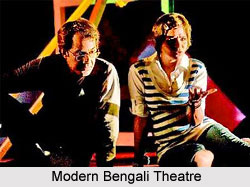 The modern Bengali theatre, with the influx of the democratized public theatre in 1872, had completed its journey away from the clutches of the babus and Orientalists to the broader, more democratic level of the ticketed theatre which soon became professional under the leadership of Girish Chandra Ghosh, Ardhendu Shekhar Mustaphi, and Amrita Lal Basu etc.
The modern Bengali theatre, with the influx of the democratized public theatre in 1872, had completed its journey away from the clutches of the babus and Orientalists to the broader, more democratic level of the ticketed theatre which soon became professional under the leadership of Girish Chandra Ghosh, Ardhendu Shekhar Mustaphi, and Amrita Lal Basu etc.
The phase of Bengali theatre from 1872-1912 was a glorious time. By 1867, Girish Ghosh had formed a Jatra troupe at Baghbajar that put up a production of Madhusudan Dutt`s Sharmishtha. With Ghosh were his friends Nagendra Lal Bandyopadhyay, Dharmadas Sur and Radhamadhab Kar, each of whom would later become movers and shakers of the professional Bengali theatre. They called their company the Baghbajar Amateur Theatre and deliberately chose Dutta`s Western-style play, performing it in the Jatra style, a style earlier abhorred by both the British as well as the babus.
And since it was so despised by the British, Jatra always received almost unanimous scorn from the puritanical babus, especially those with an English education. Its popularity among the lower and non-literate classes of Kolkata made it impossible for Jatra to be acceptable to the first modernists of Bengal, its nineteenth-century literati.
Jatra topped the list of the popular lower-class cultural entertainments that were so detested by the literati. It was maladjusted to the high order of Sanskrit culture that the scene had ordained for the native intelligentsia.
However, the scorn was not altogether free of ambiguity; there was a consciousness that both the Jatra and the Sanskrit language had similar origins. It was always/already the `performance` of it that had to become reprehensible; the enactment was scarred, ruining what otherwise might have been an acceptable core text. The text had to be rescued and made fit for the newly emergent colonial standards. But not all Jatra performances were of poor quality; some were even, better than public theatre plays.
Jatra could be proper and acceptable, even exceed theatrical standards, but only when rules were followed. With the secular quality of life in Kolkata and with the traditional caste-lines fast disintegrating under the impact of colonial free enterprise, the nature of the traditional, devotional Jatra had started to make way for thematically more generalized performances that would attract all sorts of audiences.
Several professional Jatra companies had emerged that found welcome consumers among the Kolkata audiences. This, in turn, defined popular taste and, very soon, secular Jatra plays became the norm and rage of the town. A large section of the babu class received these plays well and patronized them. But another section, especially those that had received an English education, resisted and rejected Jatra in all its manifestations. There was a middle section, too, among the babus - people who wanted to liberate Jatra from `low art` influences and return it to the hallowed days of the Vaishnab religious or devotional Krishnajatra [Jatra plays about the life of the Hindu god Lord Krishna].
 Efforts were made to re-write Jatra plays in the older devotional mode. New stage devices and internal norms with stock characters emerged in this new, hybridized Jatra. A good instance would be the internal device that almost each and every Jatra play used as a starter: the prologue between a sweeper (jamadar or methar), occasionally accompanied by his wife (the methrani), a water-seller (bhishtiwala) and a coachman (nakib) who is to drive some important royal person through the streets. The setting, consequently, was in most cases a sarkari path or state highway. The subject of the conversation, punctuated with parody songs, was usually regarding the water-seller`s refusal to work for non-payment. The dialogue was always colloquial and in pidgin Bengali, mixing rural Bengali language dialects and supplemented, at times, with a smattering of ungrammatical Hindi language. This prologue was a stock beginning and had little or nothing to do with the general subject of the play. Even plays of very different kinds would have the same kind of prologues with slight variations. Towards the end of the nineteenth century, the new devotional Jatras, too, picked up this device.
Efforts were made to re-write Jatra plays in the older devotional mode. New stage devices and internal norms with stock characters emerged in this new, hybridized Jatra. A good instance would be the internal device that almost each and every Jatra play used as a starter: the prologue between a sweeper (jamadar or methar), occasionally accompanied by his wife (the methrani), a water-seller (bhishtiwala) and a coachman (nakib) who is to drive some important royal person through the streets. The setting, consequently, was in most cases a sarkari path or state highway. The subject of the conversation, punctuated with parody songs, was usually regarding the water-seller`s refusal to work for non-payment. The dialogue was always colloquial and in pidgin Bengali, mixing rural Bengali language dialects and supplemented, at times, with a smattering of ungrammatical Hindi language. This prologue was a stock beginning and had little or nothing to do with the general subject of the play. Even plays of very different kinds would have the same kind of prologues with slight variations. Towards the end of the nineteenth century, the new devotional Jatras, too, picked up this device.
Yet it was into this same Jatra form that Girish Ghosh and his friends, the first actors of the Bengali public theatre, wanted to recast Michael Madhusudan Dutt`s play, because he wanted an amalgamation of theatre and [Jatra]; all his life he sought to master the technique of theatre: its five-act drama-structure, its refined human conflict, its sophisticated suspense and catharsis, but he wanted to infuse it with whatever was lively and powerful in the traditional [Jatra]. Above all he wanted to free the theatre from the whims of a bourgeois audience; he wanted the `public` in his theatre, a public he knew so well and could tell unerringly what pleased it and what did not. This transition from Jatra to Modern Bengali theatre was a combination of frustration with the amateur quality of Bengali theatre on the one hand, and a desire to connect with a larger audience on the other. At the same time there must have been the wish to escape the control of the whimsical babus, whose sprawling mansions had no place for the riff-raff of the black quarters who went to see Jatra performances, that made Ghosh and his band attempt a professional outfit. The folk Jatra had evolved apace with the tides of popular taste, not stopping to care for high and low art, bhadralok or babu class.




